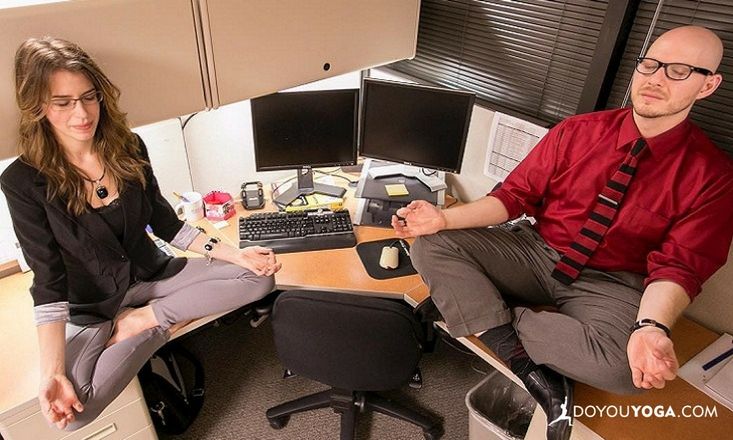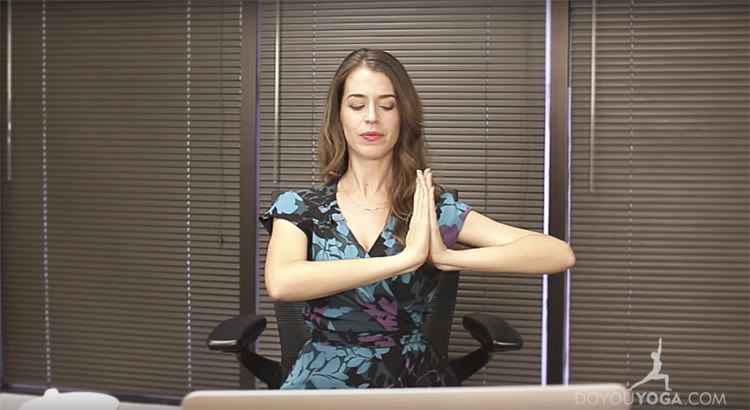I always tell my students that the best way to practice yoga is to incorporate it throughout your day. Doing several 5 to 20-minute mini yoga practices when your brain and body need a break most, may be even more effective than doing one full, 60-minute class.
Plus, for many of us busy people, it is more likely to actually happen. You probably could use a break right now. This routine is composed of yoga poses you can do at your desk and will take just 5-10 minutes, so try it out as you read.
Wrist Stretch
How to: Bring your hands to a prayer position. Press both hands to the right (so you feel a deeper stretch in your right wrist) and hold for 3-5 breaths. Repeat on the left side.
Therapeutic Benefits: If you have been typing a lot, this helps to prevent wrist pain and carpal tunnel syndrome. Carpal tunnel can be fairly serious, leading to severe pain and even surgeries. The good news is you can prevent it (and even reverse it) by doing simple stretches like this.
Chair Twist
How to: Ground your feet down on the floor. Sit as tall as you can. Bring both of your hands to the right side of your chair (perhaps the arm or seat of the chair). Maintain the length in your spine as you gently twist, using your hands for leverage to help you into the twist. Stay for approximately five breaths and repeat on the left side.
Therapeutic Benefits: No, I am not going to say that this wrings out the toxins from your organs. As a physiology teacher, I don’t even know what yoga teachers mean when they say that!
However, this is beneficial for your spinal disc health (warning if you currently have a bulging or herniated disc, you might want to skip this one or do it super gently, focusing on lengthening up more instead of twisting more.) This also stretches muscles around your core, increases circulation, stimulates digestion, and can help alleviate back pain.
Chair Pose
How to: Stand with your feet parallel and hip-distance apart. Bend into your knees, coming down as if you are going to sit back in a chair. Keep your spine neutral and core engaged. Feel free to keep your hands on your hips or, if your back and core are strong, lift your arms up into a big “V” shape.
Take 5-10 deep breaths and then stand up straight. Repeat up to three times in a row. Bonus: this may boost confidence. Check out my article here to learn more about the science of power poses like this.
Therapeutic Benefits: This is especially beneficial if you have been sitting for a long time. The human body is not meant to sit as much as we do in the modern day. This pose is one of the most powerful and effective poses for increasing circulation (of blood and lymph from a physiology perspective, and of prana from a yogic perspective).
Actually, if I had to choose just one pose to do as a break from work for you to get the best bang for your time investment, this would be it. One reason is that, in Chair pose, you are activating the largest muscles in your body (including the quadriceps, gluteals, and core).
Desk Downward Dog
How to: Bring your hands to a desk and step back as far as comfortable. Feel free to pedal your feet to warm into the back of your leg muscles.
Therapeutic Benefits: Down Dog safely stretches the whole back side of your body (including your hamstrings and calf muscles) and stretches your shoulders. If you have been sitting a lot, your hamstrings need this stretch and if you have been wearing heels, your calf muscles are asking for this!
Chair Pigeon
How to: Bring your right ankle to your left thigh. This may be enough of a stretch. If you need more, gently hinge at the hip and lean your torso forward until you feel it. Hold for at least 5-10 breaths and repeat on the other side.
Therapeutic Benefits: This can prevent or alleviate sciatica, which can cause numbness in the legs and feet. Sciatica can be a huge issue for people that sit or stand a lot. Pigeon pose stretches key muscles that, when tight, can contribute to sciatica, including the piriformis (a deep butt muscle that can press on a big nerve called the sciatic) along with the hamstrings.
End your practice by sitting tall, taking a few deep breaths. Feel the resulting sensations and mental clarity from just a few minutes of practice. If you like this and want more, join my Office Yoga Challenge for free 10-minute guided practices. Hope to see you there!
Image credit: Ann Swanson







